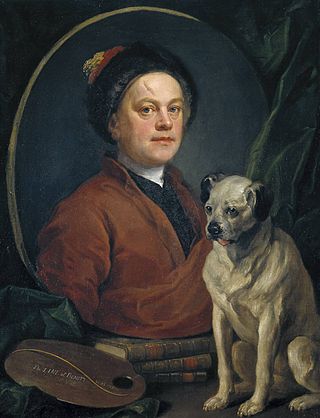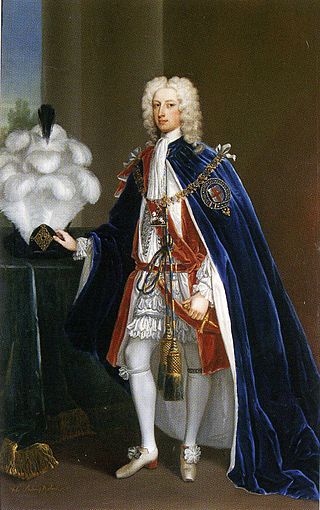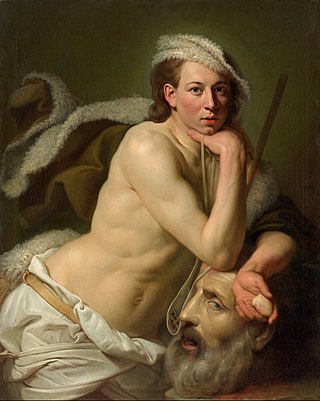
Sir Joshua Reynolds was an English painter who specialised in portraits. John Russell said he was one of the major European painters of the 18th century. He promoted the "Grand Style" in painting, which depended on idealisation of the imperfect. He was a founder and first president of the Royal Academy of Arts and was knighted by George III in 1769.

William Hogarth was an English painter, engraver, pictorial satirist, social critic, editorial cartoonist and occasional writer on art. His work ranges from realistic portraiture to comic strip-like series of pictures called "modern moral subjects", and he is perhaps best known for his series A Harlot's Progress, A Rake's Progress and Marriage A-la-Mode. Knowledge of his work is so pervasive that satirical political illustrations in this style are often referred to as "Hogarthian".

Maria Anna Angelika Kauffmann, usually known in English as Angelica Kauffman, was a Swiss Neoclassical painter who had a successful career in London and Rome. Remembered primarily as a history painter, Kauffmann was a skilled portraitist, landscape and decoration painter. She was, along with Mary Moser, one of two female painters among the founding members of the Royal Academy in London in 1768.

Joseph Nollekens R.A. was a sculptor from London generally considered to be the finest British sculptor of the late 18th century.

Henry Fuseli was a Swiss painter, draughtsman, and writer on art who spent much of his life in Britain. Many of his works depict supernatural experiences, such as The Nightmare. He painted works for John Boydell's Shakespeare Gallery and created his own "Milton Gallery". He held the posts of Professor of Painting and Keeper at the Royal Academy. His style had a considerable influence on many younger British artists, including William Blake.

John Opie was an English historical and portrait painter. He painted many great men and women of his day, including members of the British Royal Family, and others who were notable in the artistic and literary professions.

Pompeo Girolamo Batoni was an Italian painter who displayed a solid technical knowledge in his portrait work and in his numerous allegorical and mythological pictures. The high number of foreign visitors travelling throughout Italy and reaching Rome during their "Grand Tour" led the artist to specialize in portraits.

Arthur Murphy, also known by the pseudonym Charles Ranger, was an Irish writer and barrister. He established himself in London as a leading playwright.

John Manners, 3rd Duke of Rutland KG PC was an English nobleman, the eldest son of John Manners, 2nd Duke of Rutland and Catherine Russell. Styled Marquess of Granby from 1711, he succeeded to the title in 1721, cutting short a brief career in the House of Commons, where he had represented Rutland as a Whig.

William Mason was an English poet, divine, amateur draughtsman, author, editor and gardener.

Louis-François Roubiliac was a French sculptor who worked in England. One of the four most prominent sculptors in London working in the rococo style, he was described by Margaret Whinney as "probably the most accomplished sculptor ever to work in England".

Johan Joseph Zoffany was a German neoclassical painter who was active mainly in England, Italy and India. His works appear in many prominent British collections, including the National Gallery, the Tate Gallery and the Royal Collection, as well as institutions in continental Europe, India, the United States and Australia. His name is sometimes spelled Zoffani or Zauffelij.

Lady Diana Beauclerk was an English noblewoman and celebrated artist.

The Boydell Shakespeare Gallery in London, England, was the first stage of a three-part project initiated in November 1786 by engraver and publisher John Boydell in an effort to foster a school of British history painting. In addition to the establishment of the gallery, Boydell planned to produce an illustrated edition of William Shakespeare's plays and a folio of prints based upon a series of paintings by different contemporary painters. During the 1790s the London gallery that showed the original paintings emerged as the project's most popular element.

Samuel William Reynolds was a mezzotint engraver, landscape painter and landscape gardener. Reynolds was a popular engraver in both Britain and France and there are over 400 examples of his work in the National Portrait Gallery, London.

David Garrick as Richard III is a painting dating from 1745 by the English artist William Hogarth.
Edward Fisher (1730–c.1785) was an Irish-born mezzotint engraver, mostly of portraits, working in London.

Distracted boyfriend is an Internet meme based on a 2015 stock photograph by Spanish photographer Antonio Guillem. Social media users started using the image as a meme at the start of 2017, and it went viral in August 2017 as a way to depict different forms of disloyalty. The meme has inspired various spin-offs and received critical acclaim.

In 1757, the actor David Garrick commissioned the sculptor Louis-François Roubiliac to make a full-size marble statue of William Shakespeare for Garrick's octagonal Temple to Shakespeare, erected near his villa beside the River Thames at Hampton, to the west of London. The sculpture cost 300 guineas and was installed at Garrick's temple in 1758; it remained there until it was bequeathed to the British Museum along with Garrick's books in 1779. The sculpture was transferred to the new British Library in 2005, where it is displayed on a new travertine plinth beside the main staircase in the main entrance hall.

Elizabeth Catherine Hunter, Lady Clarke, best known as Kitty Hunter, was an English noblewoman. She was the daughter of Thomas Orby Hunter, a member of parliament and lord of the Admiralty. In 1762, she eloped to mainland Europe with Henry Herbert, 10th Earl of Pembroke, causing a scandal. A year later the couple returned to England and Pembroke reconciled with his wife. Hunter had a son by Pembroke, Augustus Retnuh Reebkomp, who was supported by the Pembroke family and became a naval officer. Hunter was the mistress of Augustus Hervey before marrying army officer Alured Clarke. When Clarke was knighted she became known as Lady Clarke.





















